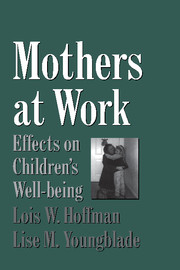Book contents
- Frontmatter
- Contents
- Preface
- 1 Introduction and Review of the Literature
- 2 Methodology
- 3 Children's Daily Family Lives: The After-School Day Interview
- 4 The Husband–Wife Relationship
- 5 The Mother's Well-being
- 6 Childrearing
- 7 Maternal Employment and Child Outcomes: The Direct Relationships
- 8 The Father's Role, Gender Attitudes, and Academic Outcomes
- 9 The Mother's Well-being and Child Outcomes
- 10 Childrearing Patterns and Child Outcomes
- 11 Nonmaternal Care and Supervision: Prevalence and Effects of Child-care Arrangements on Child Well-being
- 12 Summary and Overview
- Appendix: Measures Developed for This Study
- References
- Author Index
- Subject Index
3 - Children's Daily Family Lives: The After-School Day Interview
Published online by Cambridge University Press: 06 July 2010
- Frontmatter
- Contents
- Preface
- 1 Introduction and Review of the Literature
- 2 Methodology
- 3 Children's Daily Family Lives: The After-School Day Interview
- 4 The Husband–Wife Relationship
- 5 The Mother's Well-being
- 6 Childrearing
- 7 Maternal Employment and Child Outcomes: The Direct Relationships
- 8 The Father's Role, Gender Attitudes, and Academic Outcomes
- 9 The Mother's Well-being and Child Outcomes
- 10 Childrearing Patterns and Child Outcomes
- 11 Nonmaternal Care and Supervision: Prevalence and Effects of Child-care Arrangements on Child Well-being
- 12 Summary and Overview
- Appendix: Measures Developed for This Study
- References
- Author Index
- Subject Index
Summary
The sample of families used in this study has been described in the previous chapter using traditional demographic categories such as race, marital status, and social class. It is clear from these numbers that we studied a heterogeneous population, but such statistics tend to blur the distinctions between individual families, leaving the reader with the impression that all “single, employed mother” or “married, father employed/mother homemaker” families are somehow the same. Indeed, the goal of research often seems to be to make generalizations about categories. What is obscured in research, mass media coverage, and in many people's minds is the wide variation that occurs within any category. What is also obscured is the wide variety of family forms, adaptations, and routine behavior patterns that children experience – even in Middle America.
The other chapters in this book conform to the standard social science research procedures. Here, however, we want to tap into the more qualitative data that were obtained to provide a fuller picture than that offered by statistical analysis. A particular strength of this project was the vast array of data on each family. These data came from multiple reporters and a variety of measures, ranging from objective, standardized instruments to openended questions that elicited free personal responses. A particularly unique measure was the children's interview, in which children gave detailed descriptions of daily family life. These interviews, called the After School Day, were described in Chapter 2.
- Type
- Chapter
- Information
- Mothers at WorkEffects on Children's Well-Being, pp. 45 - 75Publisher: Cambridge University PressPrint publication year: 1999



